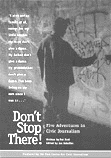Winter 1999
Don’t Stop There!
 “I ain’t got no family at all, except for my little brother. My mom don’t give a damn. My father don’t give a damn. My grandmother don’t give a damn. I’ve been living on my own since I was 13.”
“I ain’t got no family at all, except for my little brother. My mom don’t give a damn. My father don’t give a damn. My grandmother don’t give a damn. I’ve been living on my own since I was 13.”
To “Sin,” a graffiti-scrawling teenager featured in a project on juvenile crime mounted by the News-Leader in Springfield, Missouri, life is tough. It’s easy to see how “Sin” could have become emblematic of the pathos and disaffection of youth. But the News-Leader set a more complex goal in presenting a fuller portrait of “Sin” as just one figure in the story of teenage life in Spring-field.
And that’s why “Sin” graces the cover of the new Pew Center publication, “Don’t Stop There!” The book is an examination of reporting that didn’t stop at the easy stereotypes or official statistics but, using the tools of civic journalism, engaged the larger community in a full discussion of important issues.
Projects in five communities were studied in depth:
“Don’t Stop There!” details the journalistic processes involved in launching these efforts – the inspiration for choosing a topic, the planning, the tools used in executing it and the way different news organizations played the finished product. Because these were civic journalism projects, the book also examines the impact they had on the community.
Each project is unique to the community it served. In Maine, with its town meeting form of government and Yankee outspokenness, the Portland media convened a discussion group to engage citizens in the 1996 elections. But in Binghamton, where paternalistic employers had rendered citizens somewhat passive, the newspaper assembled action groups to address economic issues.
Yet each project also generated ideas and lessons that could be applied in projects anywhere. For example, Peoria Journal Star editor Jack Brimeyer learned the importance of following a project right through the layout stage, when an unfortunate headline over the first installment of his leadership project nearly undid his efforts.
“Don’t Stop There!” also documents the way the projects affected the newsrooms, themselves. Almost uniformly, reporters picked up tools that have helped them improve their normal, daily coverage. As project editor Kate Parry, at the St. Paul Pioneer Press, observed, “People talk about civic journalism as a way to get citizens to engage in their community. I think it gets journalists to engage in their community.”
At 64 pages, the book is an easy read and it tells the stories-behind-the-stories in a compelling way. It will be fun for reporters, editors and news directors to read what their colleagues around the country are doing. And it will be useful for anyone involved in the field of journalism to see how these organizations are advancing the ball.
“Don’t Stop There!” is now available free of charge from the Pew Center. Call 202-331-3200 to order a copy.
